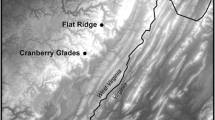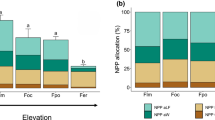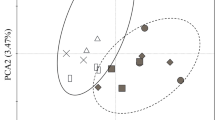Abstract
Efforts to improve models of terrestrial productivity and to understand the function of tropical forests in global carbon cycles require a mechanistic understanding of spatial variation in aboveground net primary productivity (ANPP) across tropical landscapes. To help derive such an understanding for Borneo, we monitored aboveground fine litterfall, woody biomass increment and ANPP (their sum) in mature forest over 29 months across a soil nutrient gradient in southwestern Kalimantan. In 30 (0.07 ha) plots stratified throughout the watershed (∼340 ha, 8–190 m a.s.l.), we measured productivity and tested its relationship with 27 soil parameters. ANPP across the study area was among the highest reported for mature lowland tropical forests. Aboveground fine litterfall ranged from 5.1 to 11.0 Mg ha−1 year−1 and averaged 7.7 ± 0.4 (mean ± 95 C.I.). Woody biomass increment ranged from 5.8 to 23.6 Mg ha−1 year−1 and averaged 12.0 ± 2.0. Growth of large trees (≥60 cm dbh) contributed 38–82% of plot-wide biomass increment and explained 92% of variation among plots. ANPP, the sum of these parameters, ranged from 11.1 to 32.3 Mg ha−1 year−1 and averaged 19.7 ± 2.2. ANPP was weakly related to fine litterfall (r 2 = 0.176), but strongly related to growth of large trees at least 60 cm dbh (r 2 = 0.848). Adjusted ANPP after accounting for apparent “mature forest bias” in our sampling method was 17.5 ± 1.2 Mg ha−1 year−1.Relating productivity measures to soil parameters showed that spatial patterning in productivity was significantly related to soil nutrients, especially phosphorus (P). Fine litterfall increased strongly with extractable P (r 2 = 0.646), but reached an asymptote at moderate P levels, whereas biomass increment (r 2 = 0.473) and ANPP (r 2 = 0.603) increased linearly across the gradient. Biomass increment of large trees was more frequently and strongly related to nutrients than small trees, suggesting size dependency of tree growth on nutrients. Multiple linear regression confirmed the leading importance of soil P, and identified Ca as a potential co-limiting factor. Our findings strongly suggest that (1) soil nutrients, especially P, limit aboveground productivity in lowland Bornean forests, and (2) these forests play an important, but changing role in carbon cycles, as canopy tree logging alters these terrestrial carbon sinks.







Similar content being viewed by others
References
Achard F, Eva HD, Stibig HJ, Mayaux P, Gallego J, Richards T, Malingreau J-P. 2002. Determination of deforestation rates of the world’s humid tropical forests, Science 297:999–1002
Ashton PS, Hall P. 1992. Comparisons of structure among mixed dipterocarp forests of north-western Borneo. J Ecol 60:305–24
Baker TR, Swaine MD, Burslem DFRP. 2003b. Variation in tropical forest growth rates: combined effects of functional group composition and resource availability. Perspect Plant Ecol Evol Systemat 6:21–36
Bowman R. 1990. A rapid method to determine total phosphorus in soils. J Soil Sci Soc Am 52:1301–4
Braswell DS, Schimel DS, Linder E, Moore B III. 1997. The response of global terrestrial ecosystems to interannual temperature variability. Science 278:870–2
Brown S. 1997. Estimating biomass and biomass change of tropical forests: a primer. UN FAO Forestry Paper 134. Food and Agriculture Organization, Rome
Cannon CH, Leighton M. 2004. Tree species distributions across five habitats in a Bornean rainforest. J Vegetat Sci 15:257–66
Cannon CH, Peart DR, Leighton M. 1998. Tree species diversity in commercially logged Bornean rainforest. Science 281:1366–8
Chambers JQ, Higuchi N, Tribuzt ES, others. 2001. Carbon sink for a century. Nature 410:29
Chapman CA, Chapman LJ. 2004. Unfavorable successional pathways and the conservation value of logged tropical forest. Biodiversity Conservat 13:2089–105
Chave J, Condit R, Lao S, Caspersen JP, Foster RB, Hubbell SP. 2003. Spatial and temporal variation of biomass in a tropical forest: results from a large census plot in Panama. J Ecol 91:240–52
Churkina G, Running SW, Schloss AL, Participants of the Potsdam net primary productivity model intercomparison. 1999. Comparing global models of terrestrial net primary productivity (NPP): the importance of water availability. Global Change Biol 5(S1):46–55
Clark DB, Clark DA. 2000. Landscape-scale variation in forest structure and biomass in a tropical rain forest. Forest Ecol Manage 137:185–98
Clark DA, Brown S, Kicklighter D, Thomlinson JR, Ni J. 2001a. Net primary production in tropical forests: an evaluation and synthesis of existing field data. Ecol Appl 11:371–84
Clark DA, Brown S, Kicklighter D, Thomlinson JR, Ni J. 2001b. Measuring net primary production in forests: concepts and field methods. Ecol Appl 11:371–84
Curran LM, Leighton M. 2000. Vertebrate responses to spatio-temporal variation in seed production by mast-fruiting Bornean Dipterocarpaceae. Ecol Monogr 70:101–28
Curran LM, Caniago I, Paoli GD, Astiani D, Kusneti M, Leighton M, Nirarita CE, Haeruman H. 1999. Impact of El Niño and logging on canopy tree recruitment in Borneo. Science 286:2182–8
Curran LM, Webb CO. 2000. Experimental tests of the spatiotemporal scale of seed predation in mast-fruiting Dipterocarpaceae. Ecol Monogr 70:129–48
Curran LM, Trigg SN, McDonald AK, Astiani D, Hardiono YM, Siregar P, Caniago I, Kasischke E. 2004. Lowland forest loss in protected areas of Indonesian Borneo. Science 303:1000–3
Davidson EA, Reis de Carvalho CJ, Vieiria ICG, others. 2004a. Nitrogen and phosphorus limitation of biomass growth in a tropical secondary forest. Ecol Appl 14:S150–S163
Davidson EA, Neil C, Krusche AU, Markewitz D, Figueiredo P. 2004b. Loss of nutrient from terrestrial ecosystems to streams and the atmosphere following land use change in Amazonia. Ecosystems Land Use Change 10:147–58
De Walt SJ, Chavez J. 2004. Structure and biomass of four lowland Neotropical forests. Biotropica 36:7–19
DeFries RS, Houghton RA, Hansen MC, others. 2002. Carbon emissions from tropical deforestation and regrowth based on satellite observations for the 1980s and 1990s. Proc Natl Acad Sci 99:14256–61
Houghton RA. 2005. Aboveground forest biomass and the global carbon balance. Global Change Biol 11:945–58
Houghton RA, Lawrence KT, Hackler JL, others. 2001. The spatial distribution of forest biomass in the Brazilian Amazon: a comparison of estimates. Global Change Biol 7:731–46
Kitayama K, Aiba S. 2002. Ecosystem structure and productivity of tropical rain forests along altitudinal gradients with contrasting soil phosphorus pools on Mount Kinabalu, Borneo. J Ecol 90:37–51
Lawrence D, Schlesinger WL. 2001. Changes in the distribution of soil phosphorus over 200 years of shifting cultivation. Ecology 82:2769–80
Malhi Y, Baker TR, Phillips O, others. 2004. The above-ground coarse wood productivity of 104 Neotropical forest plots. Global Change Biol 10:563–91
Malhi Y, Wood D, Baker TR, others. 2006. The regional variation in above-ground live biomass in old-growth Amazonian forests. Global Change Biol 12:1107–38
Mirmanto E, Proctor J, Green J, Nagy L, Suriantata. 1999. Effects of nitrogen and phosphorus fertilization in a lowland evergreen rainforest. Philos Trans R Soc London Series B 354:1825–9
Newbery DM, Chuyong GB, Green JJ, Songwe NC, Tchuenteu F, Zimmerman L. 2003. Does low phosphorus supply limit seedling establishment and tree growth in groves of ectomycorrhizal trees in a central African rainforest? New Phytol 156:297–311
Olsen SR, Cole CU, Watanabe FS, Dean LA. 1954. Estimation of available phosphorus in soils by extraction with sodium bicarbonate. USDA Circular 939:19
Paoli GD. 2004. Community and ecosystem consequences of tree species turnover along nutrient gradients in lowland rain forest of Indonesian Borneo. Ph.D. Dissertation, Michigan: University of Michigan
Paoli GD. 2006. Divergent leaf traits among congeneric tropical trees with contrasting habitat associations on Borneo. J Tropical Ecol 22:397–408
Paoli GD, Curran LM, Slik F (in press) Soil influences on aboveground biomass and emergent tree density in lowland Bornean forest
Paoli GD, Peart D, Leighton M, Samsoedin I. 2001. An ecological and economic assessment of the nontimber forest product gaharu wood at Gunung Palung National Park, West Kalimantan, Indonesia. Conserv Biol 15:1721–32
Paoli GD, Curran LM, Zak DR. 2005. Phosphorus efficiency of aboveground productivity in Bornean rain forest: evidence against the unimodal efficiency hypothesis. Ecology 86:1548–61
Paoli GD, Curran LM, Zak DR. 2006. Soil nutrients and beta diversity in the Bornean Dipterocarpaceae: evidence for niche partitioning by rain forest trees. J Ecol 94:157–70
Pendry C, Proctor J. 1996. The causes of altitudinal zonation of rain forests on Bukit Belalong, Brunei. J Ecol 84:407–18
Phillips OL. 1996. Long-term environmental change in tropical forests: increasing tree turnover. Environ Conserv 23:235–48
Phillips OL, Hall P, Gentry AH, Sawyer SA, Vasquez R. 1994. Dynamics and species richness of tropical rain forests. Proc Natl Acad Sci 91:2805–9
Proctor J, Anderson JM, Chai P, Vallack HW. 1983. Ecological studies in four contrasting lowland rain forests in Gunung Mulu National Park, Sarawak. I. Forest environment, structure and floristics. J Ecol 71:237–60
Proctor J, Lee YF, Langley AM, Munro WRC, Nelson T. 1988. Ecological studies on Gunung Silam, a small ultrabasic mountain in Sabah, Malaysia. I. Environment, forest structure and floristics. J Ecol 76:320–40
Proctor J, Phillips C, Duff DK, Heaney A, Robertson FM. 1989. Ecological Studies on Gunung Silam, a small ultrabasic mountain in Sabah, Malaysia. II. Some forest processes. J Ecol 77:317–31
Putz FE. 1983. Liana biomass and leaf area of a “Terra Firme” forest in the Rio Negro Basin, Venezuela. Biotropica 15:185–9
Rawls WJ. 1983. Estimating soil bulk density from particle size analysis and organic matter content. Soil Sci 135:123–5
Regional Physical Planning Program for Transmigration---RePPROT (1986/87) Kalimantan
Saugier B, Roy J, Mooney HA. 2001. Estimates of global terrestrial productivity: converging towards a single number? In: Terrestrial global productivity. San Diego: Academic, pp. 543–557
Schurr EAG. 2003. Productivity and global climate revisited: the sensitivity of tropical forest growth to precipitation. Ecology 84:1165–70
Siegert F, Rueker G, Hinrichs A, Hoffman AA. 2001. Increased damage from forest fires in logged forests during drought caused by El Nino. Nature 414:437–40
Sist P, Sheil D, Kartawinata K, Priyadi K. 2003. Reduced-impact logging in Indonesian Borneo: some results confirming the need for new silvicultural prescriptions. For Ecol Manage 179:415–27
Slik JWF, Poulsen AD, Ashton PS, Cannon CH, Eichhorn KAO, Kartawinata K, Lanniari I, Nagamasu H, Nakagawa M, van Nieuwstadt MGL, Payne J, Purwaningsih, Saridan A, Sidiyasa K, Verburg RW, Webb CO, Wilkie P. 2003. A floristic analysis of the lowland dipterocarp forest of Borneo. J Biogeogr 30:1517–31
van der Werf GR, Randerson JT, Collatz GJ, Giglio L, Kasibhatla S, Arellano AF, Olsen SC, Kasischkecs. 2004. Continental-scale partitioning of fire emissions during the 1997 to 2001 El Nino/La Nina period. Science 303:73–6
Vieira S, Barbosa de Camargo P, Selhorst D, others. 2004. Forest structure and carbon dynamics in Amazonian tropical rain forests. Oecologia 140:468–79
Vitousek PM. 1984. Litterfall, nutrient cycling, and nutrient limitation in tropical forests. Ecology 65:285–98
Vitousek PM. 2004. Nutrient cycling and limitation: Hawai’i as a model system. New Jersey: Princeton University Press
Walker TW, Zimmerman JK, Lodge DJ, Guzman-Grajales S. 1996. An altitudinal comparison of growth and species composition in hurricane-damaged forests in Puerto Rico. J Ecol 84:877–89
Whitmore TC. 1984. Rain forest of the Far East. Second Edition. Oxford: Clarendon
Yamakura T, Hagihara A, Sukardjo S, Ogawa H. 1986. Aboveground biomass of tropical rain forest stands in Indonesian Borneo. Vegetatio 68:71–82
Acknowledgments
We are grateful to the Indonesian Institute of Sciences (LIPI) and the Department of Forest Protection and Nature Conservation (PHKA) for granting permission to conduct research in Indonesia. We thank our Indonesian sponsor, the Center for Research and Development in Biology (PPPB), for logistical support, and the students and faculty of Universitas Tanjungpura, for participating as our research counterparts. Farizal, Hon, Tang and Morni provided vital assistance in the field, and A. Budiman, Sugarjito, Ibu Ina, N. Paliama, and M. Sinaga provided logistical support. We thank R. Houghton, L. De Mattia, D. Goldberg, A. Gorog, K. Judd, S. Trigg, J. Vandermeer, D. Zak and three anonymous reviewers for critical comments, and M. Hardiono and A. McDonald Pittman for GIS computations of geological substrate and land use categories. Financial support for G.D.P. from the Fulbright Indonesia Program and the University of Michigan and L.M.C. from NASA Earth Science Program (NAG 511335 and 511161), the University of Michigan and the Yale School of Forestry and Environmental Studies and the Santa Fe Institute.
Author information
Authors and Affiliations
Corresponding author
Electronic supplementary material
Rights and permissions
About this article
Cite this article
Paoli, G.D., Curran, L.M. Soil Nutrients Limit Fine Litter Production and Tree Growth in Mature Lowland Forest of Southwestern Borneo. Ecosystems 10, 503–518 (2007). https://doi.org/10.1007/s10021-007-9042-y
Received:
Accepted:
Published:
Issue Date:
DOI: https://doi.org/10.1007/s10021-007-9042-y




